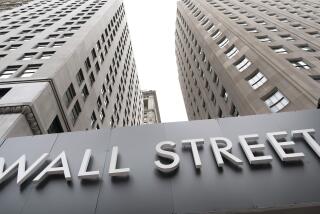Microsoft Tops List of Nasdaq Firms Being Lured by NYSE : Markets: The software giant hasn’t decided whether to jump to the Big Board. Its departure would be a blow.
NEW YORK — Amid two federal investigations of Nasdaq, the New York Stock Exchange said Thursday it expects to lure a record number of companies from its rival this year and has set its sights at the very top: Microsoft, the over-the-counter market’s biggest firm.
Richard A. Grasso, the NYSE’s president and soon-to-be chairman, told reporters in San Francisco late Wednesday that the Redmond, Wash., software giant is his primary target. Sources close to Microsoft said it has made no decision on whether to leave Nasdaq, but in recent months has stepped up an internal review of whether to switch its listing.
Gregory Maffei, Microsoft’s treasurer, said he had no statement on the subject except to say, “It’s gratifying to know that we’re desired.” Sources said Grasso met recently with Microsoft executives.
In part to encourage Microsoft to stay, Nasdaq recently made the firm’s chief financial officer, Michael Brown, a member of its board.
The departure of Microsoft would be a major blow to Nasdaq, which has heavily advertised itself as the home of successful high-technology companies. But even if Microsoft doesn’t jump ship, a significant number of Nasdaq’s other big companies are.
So far this year, 11 have announced that they are moving, up from seven in the first quarter of 1994, NYSE officials said. And on Thursday, Robert G. Britz, the NYSE’s senior vice president in charge of new listings, said the Big Board already has commitments from enough companies to break a record set in 1988 for the number of companies moving their stock from Nasdaq to the NYSE.
In 1988, 52 companies moved, mostly in response to the October, 1987, stock market crash. Nasdaq was heavily criticized by regulators after the crash because many of its dealers simply stopped answering their telephones as stock prices plunged. Last year, 45 companies jumped to the NYSE.
Nasdaq lists the securities of 4,900 companies--including Apple Computer, Intel and MCI Communications--but only a small percentage of its firms are big enough to qualify for NYSE listing.
James D. Spellman, Nasdaq’s spokesman, dismissed Grasso’s targeting of Microsoft as “campaign rhetoric.” “We expect 1995 to be another successful, strong year for Nasdaq,” Spellman said.
Among the companies moving so far this year are State Street Boston Corp., a bank-holding company that was Nasdaq’s 39th-biggest company, and Sonoco Products, a maker of paper and plastic goods, which ranked 43rd.
Companies that list on the Big Board seldom leave voluntarily, in part because of a NYSE rule that makes voluntary delisting very difficult. Nasdaq is asking the SEC to overturn the rule.
The Times disclosed in October that the Justice Department’s antitrust division had launched an investigation into whether dealers colluded to maintain wide spreads, or profit margins, on Nasdaq stocks. A Times series detailed other alleged improprieties on Nasdaq, and the SEC launched its own investigation.
Nasdaq has denied any wrongdoing.
Nasdaq--whose trading volume eclipsed the NYSE’s last year--has adopted stronger tactics to dissuade companies from leaving. For example, the market sent letters March 1 to directors and major holders of Sonoco attempting to persuade them that they would lose money if the company transferred its listing to the NYSE.
The letter cited an unpublished study by a Georgetown University business professor which, it said, showed that stocks making the switch suffered an average decline in price of 12.86%. Attached to the letter were calculations of how much big holders of Sonoco would lose in a 12% price drop.
However, in an interview Thursday, the study’s author, Reena Aggarwal, denied that her findings supported Nasdaq’s claims, explaining that the study contained no information that would predict if a particular stock’s price would decline after moving to the NYSE.
Asked about the 12% estimate, she said, “that’s their number, not mine.”
Spellman declined comment on the letter or Aggarwal’s claims. “We think the letter speaks for itself,” he said.
Aggarwal’s study focused on the price-earnings ratios of stocks that moved to the NYSE. It and another study done at Rice University have suggested that stocks that move to the Big Board tend to drop in price, possibly because companies choose to move when their financial performance is at a peak. NYSE officials strongly dispute that companies that move can expect a price decline.
(BEGIN TEXT OF INFOBOX / INFOGRAPHIC)
The Allure of the NYSE
Amid controversy over Nasdaq trading practices, the New York Stock Exchange has lured away 11 Nasdaq-listed company since Jan. 1
Company Date Listed on NYSE Dollar General Corp. Feb. 1 Isomedix Inc. Feb. 9 State Street Boston Corp. Feb. 14 Belding Hemingway Co. Feb. 15 Huntco Inc. Feb. 21 Tomkins PLC Feb. 21 Colonial Banc Group Inc. Feb. 24 New England Business Service Inc. Feb. 24 Public Service Co. of N. Carolina March 1 Sonoco Products Co. March 8 Furon Corp. March 8
Source: New York Stock Exchange
More to Read
Inside the business of entertainment
The Wide Shot brings you news, analysis and insights on everything from streaming wars to production — and what it all means for the future.
You may occasionally receive promotional content from the Los Angeles Times.










